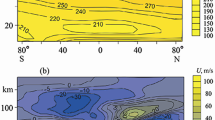Abstract
A coupled Earth’s thermosohere-ionosphere global dynamics model (for altitudes of 90–500 km) is presented. This model is based on a three-dimensional thermospheric general circulation model and a dynamical model of the ionospheric F-layer, which takes into account plasma-chemical processes, ambipolar diffusion, and advective ion transport due to neutral wind. General upper atmosphere characteristics have adequately been reproduced and the thermosphere–ionosphere interaction has quantitatively been estimated based on this coupled model. The sensitivity of thermospheric characteristics to ionospheric parameters and the sensitivity of the electron-concentration field distribution in the ionospheric F-layer to thermospheric parameters have been studied within a specified diurnal cycle.





Similar content being viewed by others
REFERENCES
D. V. Kulyamin and V. P. Dymnikov, “A three-dimensional model of general thermospheric circulation,” Russ. J. Numer. Anal. Math. Modell. 28 (4), 353–380 (2013).
D. V. Kulyamin, V. Ya. Galin, and A. I. Pogoreltsev, “The thermosphere general circulation modeling with the parametrization of radiative processes,” Russ Meteorol. Hydrol. 40, 392–399 (2015).
D. V. Kulyamin, P. A. Ostanin, and V. P. Dymnikov, “Modeling the F-layer of the Earth’s ionosphere. Solving the ambipolar diffusion equations,” Mat. Model. 31 (4), 57–74 (2019).
D. V. Kulyamin and V. P. Dymnikov, “Modeling of the lower ionosphere climate,” Izv., Atmos. Oceanic Phys. 51, 272–291 (2015).
D. V. Kulyamin and E. M. Volodin, “INM RAS coupled atmosphere–ionosphere general circulation model INMAIM (0–130 km),” Russ. J. Numer. Anal. Math. Modell. 33 (6), 351–357 (2018).
R. W. Schunk and A. Nagy, Ionospheres: Physics, Plasma Physics, and Chemistry (Cambridge University Press, London, 2009).
M. C. Kelley, The Earth’s Ionosphere, vol. 43 of Int. Geophys. Ser. (Academic Press, San Diego, CA, 1989).
E. Yigit et al., “A review of vertical coupling in the atmosphere–ionosphere system: Effects of waves, sudden stratospheric warmings, space weather, and of solar activity,” J. Atmos. Sol.-Terr. Phys. 141, 1–12 (2016).
R. W. Schunk, Solar Terrestrial Energy Program (STEP): Handbook of Ionospheric Models (Center for Atmospheric and Space Sciences, Logan, UT, USA, 1996).
A. D. Richmond, E. C. Ridley, and R. G. Roble, “A thermosphere/ionosphere general circulation model with coupled electrodynamics,” Geophys. Res. Lett. 19 (6), 601–604 (1992).
S. E. McDonald, F. Sassi, and A. J. Mannucci, “SAMI-3/SD-WACCM-X simulations of ionospheric variability during Northern winter 2009,” Space Weather 13 (9), 568–584 (2015).
T. J. Fuller-Rowell et al., “Dynamics of the low-latitude thermosphere: quiet and disturbed conditions,” J. Atmos. Terr. Phys. 59 (13), 1533–1540 (1997).
H. Wang et al., “First forecast of a sudden stratospheric warming with a coupled whole atmosphere/ionosphere model IDEA,” J. Geophys. Res.: Space Phys. 119 (3), 2079–2089 (2014).
F. S. Bessarab et al., “E-region ionospheric storm on May 1–3, 2010: GSM TIP model representation and suggestions for IRI improvement,” Adv. Space Res. 55 (8), 2124–2130 (2015).
A. V. Tashchilin and E. B. Romanova, “Numerical modeling of ionospheric plasma diffusion in the dipole geomagnetic field with a transversal drift,” Mat. Model. 25 (1), 3–17 (2013).
S. A. Ishanov et al., “α-β” Iteration algorithm in problems of ionosphere plasma modeling,” Mat. Model. 21 (1), 33–45 (2009).
V. M. Goloviznin et al., New Algorithms of Computational Hydrodynamics for Multicore Computer Systems (Izd-vo Mosk. Univ., Moscow, 2013) [in Russian].
S. V. Kostrykin, D. V. Kulyamin, P. A. Ostanin, and V. P. Dymnikov, “A model of the F-layer of the Earth’s ionosphere based on transfer and ambipolar diffusion equations,” Mat. Model. (2020) (in press).
Funding
This work was supported by the Russian Science Foundation, project no. 17-17-01305.
Author information
Authors and Affiliations
Corresponding author
Additional information
Translated by B. Dribinskaya
Rights and permissions
About this article
Cite this article
Dymnikov, V.P., Kulyamin, D.V. & Ostanin, P.A. Coupled Earth’s Thermosohere-Ionosphere Global Dynamics Model. Izv. Atmos. Ocean. Phys. 56, 241–252 (2020). https://doi.org/10.1134/S0001433820030068
Received:
Revised:
Accepted:
Published:
Issue Date:
DOI: https://doi.org/10.1134/S0001433820030068



